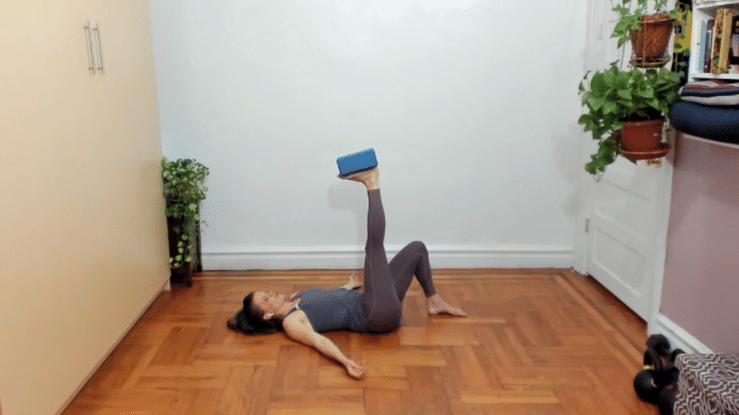I’ve recently started hearing yoga teachers use the word “constraint” in their classes. After learning about this concept a few years back in the Feldenkrais method, where I felt it mostly through the playful movement-puzzles the classes comprise, I realized that I’ve always taught yoga by incorporating constraints. The word I used for this, though, was “feedback,” and largely in the context of using props.
A constraint creates a limitation on how our body normally moves to discover some other way it can move.

There’s an endless variety of ways you could apply this concept, even in the small(ish) context of our movement practices. Above, the block creates a constraint by preventing me from rolling my ankle in (aka supinating it). If I supinated my foot with the block on it, it would fall off. This constraint helps me work my foot pronators a bit more, It also directs my awareness to my foot whereas I might otherwise be focusing on something else, like the stretch in my hamstrings.
Some folks associate props with making a pose easier, but I’ve always loved them as forms of feedback. I incorporate props to shift what’s emphasized within a pose in order to direct awareness to different places.
In other words, the prop wakes up the body to experiencing a pose in a different way, allowing new awareness and other movement patterns to emerge from something familiar.
Now to be clear, you don’t necessarily need props to apply the concept of constraint. But here are some fun propped sequences I’ve experimented with lately to teach constraint and its associated novel experience.
In the GIF below, for example, the wall is a constraint for exploring movement in my shoulder joints. Keeping at least one part of my upper extremity pressed into the wall at all times, I prevent or minimize movement of all my joints except my shoulder joints. The result of this limitation is that I target a potent stretch and activation of the tissues surrounding my shoulders.

Here the constraint is similar. In pressing my fingertips against the wall, I mobilize my spine and hips with a significant amount more of spinal rotation. This makes the range of motion I can explore at my spine in all three planes at once (tri-planar) much greater. With this constraint, I leverage positions that were otherwise unattainable.

I’ve also loved playing around with what I call the “block-head,” where you press the block and your head together to activate the sides of the neck. This helps me to move my upper back and lower back spine together with my neck spine all in one piece, rather than rotating more from my neck, which tends to be the part of our spine we like to rotate a lot from.

In this way, the block provides feedback for clearer neck alignment and stability. It activates multi-joint muscles that extend into the neck, like the paraspinals, which run along the banks of the spine’s groove and cross every vertebral joint between our sacrum and skull.

In addition to being an example of applying a constraint, this particular use of the block is also an isometric. By pressing my head into the block and resisting its movement toward lateral flexion, I activate my neck lateral flexors without changing the position of my neck.
Anytime you contract muscles around a joint without moving the joint, this type of muscle contraction is an isometric one.
Research suggests that isometrics, as a type of exercise, can induce analgesia, which is a science-y way of saying they can ease pain immediately. How’s that for making a pose feel “easier” with props?
Beyond its analgesic usefulness, this way of loading my neck can also be helpful long term to build better neck resilience, especially if we are in one position for long periods of time regularly. Additionally, it can also help our neck feel better in exercises where we might typically experience discomfort, i.e., neck discomfort in bicycles.

By changing how our body organizes tension, constraints like the ones above provide feedback that changes the way the movement or position feels.
What I’m able to feel changes what I’m able to do, and vice versa. The creativity flows both ways, and so finding ways to know myself better with props is also the way I learn to move better, too. It’s also a big reason I’m always excited to come to my practices—for an opportunity to explore and experience myself in new ways.


Leave a Reply